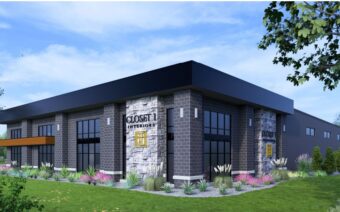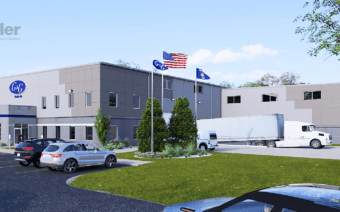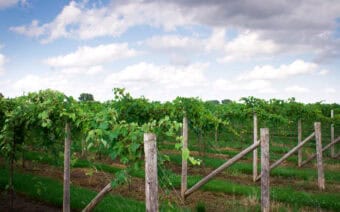
May 1, 2024
SHEBOYGAN – After 17 years of installing systems for flat-roofed commercial, industrial and residential structures across Wisconsin, Precision Roofing has expanded its “palette.”
CEO Tim Steiner said Precision has responded to customer feedback and rolled out an array of alternatives to its conventionally colorless membranes.
“A lot of people with flat roofs at their residential homes always brought up the color issue,” he said. “(Asking) if it could be painted, if you could glue carpeting onto it or anything to make it look better than what it is – black or white.”
Steiner said Precision now offers its PVC membranes – produced by Duro-Last – in light gray, light tan, blue, midnight bronze, patina, green, brown, colonial red, copper and bright red.
The new colors, he said, are available to the company’s full range of customers – suitable for any structure with a no- or low-slope roof.
Steiner said he anticipates the colored membranes will be most popular with homeowners whose roofs have a low slope visible from the ground.
White membranes, he said, are traditionally the most popular choice for businesses, as their ability to reflect sunlight helps to lower energy costs – keeping buildings naturally cool.
Others, he said, opt for Precision’s black/charcoal option, which is effective at drawing heat to help melt snow accumulated on flat roofs.
Practicality aside, Steiner said there are plenty of reasons businesses will make a selection beyond the pale or the pitch black.
“Say someone’s on the eighth floor (of a building) and there’s a roof down on the sixth floor,” he said. “Maybe they don’t want that white (membrane) up there because they don’t want the reflectivity back into their windows. Maybe they’d go with a brown or charcoal-looking color.”
Whichever color customers choose, Steiner said, every roofing system installed by Precision is backed by a 15-year warranty – or longer, with optional upgrades – and all the benefits of PVC membrane covering.
He said flat roofs have historically been topped with tar and stone.
Wisconsin’s seasons subject these roofs to expansion and contraction, which Steiner said makes them susceptible to cracking, and ultimately, leaking.
“The membranes have a little bit of expansion and contraction availability to go back to their normal size,” he said. “It’s also a much cleaner-looking roof, (especially) with the colors, and we’re able to provide that now.”
The lowdown on flat roofs
Why, particularly in a region prone to snowy winters, would a structure be built with a flat roof?
Steiner said among several reasons, the design allows for more floor space – not to mention pitched roofs and the resulting attic space are rarely necessary and often impractical for larger buildings.
He said there are aesthetic reasons for flat roofs as well.
“People like how they look a lot better,” he said. “All the air conditioners and all the big pipe stacks – that’s all hidden from the ground view.”
Snow accumulation, as well as heavy rains, Steiner said, do present the greatest challenge of maintaining a flat roof in Wisconsin.
“People call and say, ‘hey, my roof is a big swimming pool up there – what can we do?'” he said. “If the roof is perfectly flat and there are drains up there, we’ll install a foam taper system on the roof to taper that water to the roof drains, or to taper the roof to an existing gutter that’s there.”
Steiner said he wasn’t always an expert in such matters.
When he applied on a whim to work at Precision Roofing in 1999, he said the company focused on residential roofing and shingling.
“I was a laborer – cleaning up the ground, lifting the garbage into dump trailers and dump trucks and getting everyone what they needed up on the roof,” he said. “I was the grunt.”
In the 25 years since, Steiner said Precision switched its primary focus to flat roofing, as he learned the intricacies of commercial and industrial roofing for restaurants, small businesses, factories and more.
And though today he serves as the company’s CEO for more than a year, Steiner said the “grunt work” has been reduced for all 17 current employees.
“A lot of our guys did residential shingling, and they love this a lot better,” he said. “To be able to stand on a flat roof instead of a pitched roof all day, it’s a lot easier on their bodies. And, no more lifting heavy shingles.”
Steiner said the use of PVC membranes also reduces the relative danger and eliminates the unpleasant smell of using stone and tar on top roofs.

Tim Steiner said the PVC membranes Precision uses offer “the best bang for your buck” compared to membranes made from other materials. Submitted Photo
The greater challenges of Precision’s approach, he said, involve the detailed complexity of the company’s roofing process.
“It all comes from experience,” he said. “(David Balde, head of sales at Precision) and I have been on hundreds and hundreds of roofs, and we’ve seen almost everything now. Some are more challenging than others.”
The right roofing system
Each Precision project, Steiner said, is uniquely planned based on an initial roofing evaluation, with full considerations including:
Shape of the roofPipes and other objects to work aroundRemoval/replacement of layers of roofingHow much insulation R-value to installThe color of membrane to be usedGutters, drainage, metal edges and flashingsThe property around the buildingWhere to set up equipment and materials
This evaluation process, Steiner said, helps to determine the depth of each project – literally.
“We take a core sample – it’s a little two-inch, round hole,” he said. “We go all the way to the roof deck – to the wood or steel, whatever it might be – and we can tell how much insulation is on there, how many layers of roofing is on there, what kind of R-value they’re getting and if the insulation on there is wet or dry. That all determines the price for the new roof.”
Despite this thoroughness, Steiner said completing roof membranes is still speedier than alternatives.
“The process of removing and installing is a lot faster – (which means) less disruption for the business owner,” he said.
Steiner said the efficiency allows Precision to install roofs regardless of what the forecast brings.
“We work year-round,” he said. “If we have to shovel snow, we have to shovel snow. If we are removing the old roofing, we only take off enough roofing that day so we can cover it back up with the new roofing.”
Steiner said the PVC membranes Precision uses offer “the best bang for your buck” compared to membranes made from other materials – and have all but eliminated previous roof maintenance requests.
“Ever since we switched from rubber roofing to PVC Duro-Last, our (maintenance) calls have been almost nonexistent,” he said. “Seldom do we get any calls on workmanship or faulty products. Usually, third-party damage isn’t covered, but we take good care of our customers.”
Commonly, Steiner said, he estimates Precision membranes last 25-30 years, compared to other flat roofs’ average of 20 years.
The urgent calls Precision does receive, Steiner said, are typically from business owners whose older roofs are enduring prolonged stretches of heavy rain.
“At factories and offices, if you get a two- or three-day storm that comes through, that water saturates through any little opening,” he said.
Because of this, Steiner said, warmer months usually lead to a busier schedule at Precision – though he said they’re always accepting new customers.
“Sometimes in the summer, the wait gets a little longer,” he said, “but usually within four or five weeks, we can get a roof on for you – get it ordered, shipped and ready to put on.”
Visit precisionroofinginc.net for more information and a look at the new color options.
 Make-A-Wish: ‘Dreams really do come true’
Make-A-Wish: ‘Dreams really do come true’ Carbliss Ranks No. 7 on fastest-growing private companies in America list
Carbliss Ranks No. 7 on fastest-growing private companies in America list








